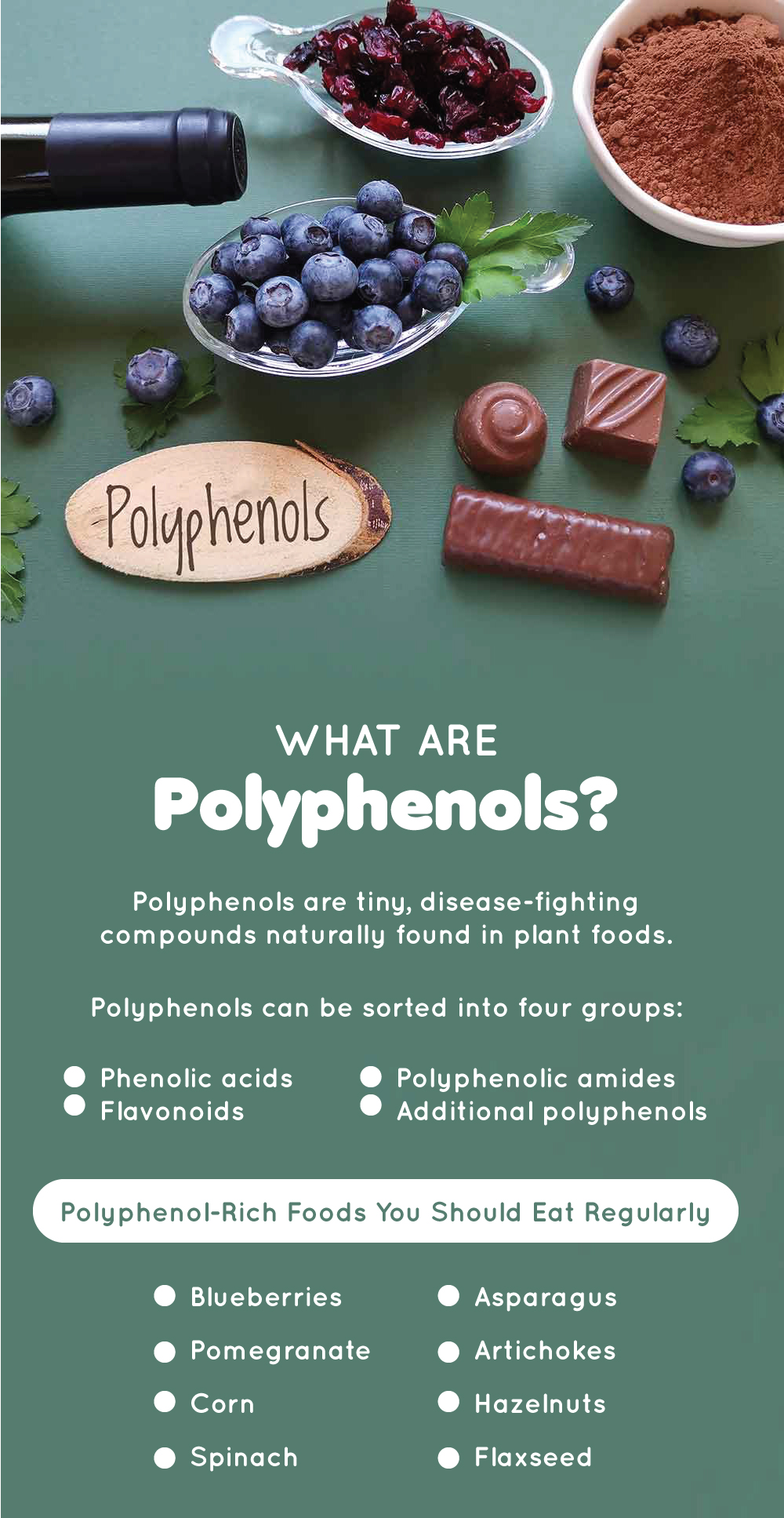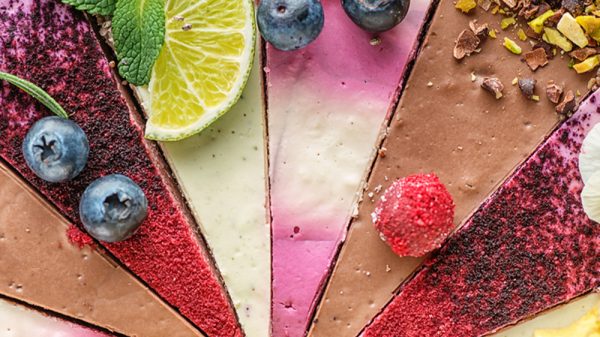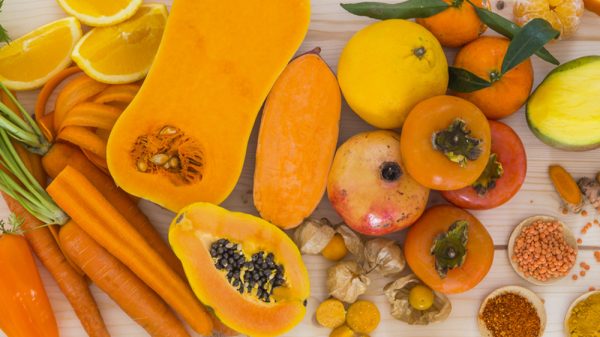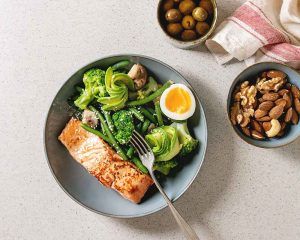When we talk about nutrition, we are usually referring to calories, fats, carbohydrates, protein, vitamins, and minerals. Recommended daily values of these nutritional components are on food labels so we know how much of each nutrient we’re eating. However, there’s more to the story. Polyphenols are tiny, disease-fighting compounds naturally found in plant foods. Keep reading to find out what polyphenols do and foods high in polyphenols that you should incorporate into your diet.
Why Are Polyphenols Important?
Polyphenols are plant compounds that scientists have been studying for their beneficial impacts on disease prevention and healing. Polyphenols can be further classified into subgroups based on their chemical structure and function. Polyphenols can be sorted into four groups: phenolic acids, flavonoids, polyphenolic amides, and additional polyphenols. (1)
Phenolic acids encompass polyphenols known as benzoic acids and cinnamic acids. These types of polyphenols can be found in whole grains, fruits, and veggies.
Flavonoids include isoflavones, flavones, flavanols, anthocyanidins, as well as other flavonoid derivatives. Rich sources of flavonoids include grapefruit, oranges, red onion, tea, coffee, cocoa powder, and purple-colored plants.
Polyphenolic amides include capsaicinoids and avenanthramides which can be found in chili peppers and oatmeal.
Additional polyphenols encompass those polyphenols that don’t fit into the groups described above. These polyphenols include resveratrol and lignans, which can be found in grapes, berries, and nuts.
Polyphenols function by scavenging free radicals in your cells that contribute to oxidative stress. Oxidative stress damages your cells and leads to sluggish metabolic processes that can raise the risk for a host of diseases.
Numerous studies reveal the benefits of consuming polyphenol foods in your diet. Polyphenols have demonstrated anti-tumor activity, anti-inflammatory activity, and antimicrobial activity. Consuming a polyphenol-rich diet has been shown to decrease cancer cell growth, decrease inflammatory liver damage, improve blood pressure, enhance brain function, create a lower risk for heart disease, promote wound-healing, and help the immune system fight off infection. (2) Eating polyphenol-rich foods may even help maintain a healthy weight, reverse insulin resistance, and improve cholesterol levels. Additionally, the polyphenols in food may also have important implications for supporting gut health. (2)

Polyphenol-Rich Foods You Should Eat Regularly
Numerous studies in scientific literature have evaluated the polyphenol content of plant foods. In one particularly comprehensive study published in the European Journal of Clinical Nutrition, researchers compiled 100 foods with the highest concentration of polyphenols. (3)
Based on research, here’s a shortlist of food sources of polyphenols you should incorporate into your diet to support optimal health and even help reverse inflammatory conditions like fatty liver disease.
1. Blueberries
A small handful of these delicious berries delivers tons of polyphenols. Cherries, raspberries, and blackberries are similarly filled with beneficial antioxidants. To incorporate more berries into your diet, top your breakfast with fresh berries or add a berry salad to your lunch.
2. Pomegranate
Pomegranate fruit is a sweet and crunchy addition to savory salads. However, pomegranate seeds are encased in a hard shell, which can be a deterrent to consuming them. Pomegranate juice provides similar benefits with high concentrations of polyphenols.
3. Corn
Interestingly and somewhat counterintuitively, corn contains a high number of polyphenols. To benefit from the polyphenol content in corn, you can eat fresh corn, corn flour, and popcorn. (4)
Whole grain wheat and rye flours are also excellent options for getting lots of polyphenols. (3)
4. Spinach
Spinach is a notoriously healthy vegetable, one reason being that it’s chock-full of polyphenols. To get spinach in your diet, add it to salads for an extra boost of antioxidants. Spinach is also a delicious side dish when sautéed with a little olive oil and garlic.
5. Asparagus
Try grilling or sautéing asparagus as an extra vegetable or salad-topper for lunch or dinner.
6. Artichokes
Who would’ve thought that artichokes are high in polyphenols? These vegetables make an excellent addition to a grilled vegetable plate or a salad. For extra polyphenols and healthy monounsaturated fats, add a drizzle of extra virgin olive oil to your artichoke dish.
7. Hazelnuts
To reap the benefits of the polyphenols in hazelnuts, try incorporating them into a trail mix with dark chocolate chips and dried cherries. Pecans and walnuts work well in trail mix too, while affording lots of antioxidants. Alternatively, try crumbling nuts on your breakfast oatmeal or lunchtime salads.
8. Flaxseed
Flaxseeds are filled with lignans as well as alpha-linolenic acid (ALA), a plant source of omega- 3 fatty acids. Flaxseed is most bioavailable when it is consumed as ground flaxseed or flaxseed meal. Ground flaxseed is a nutty addition to oatmeal. It can also be seamlessly added smoothies and stews, as well as baking recipes as a binding agent.
Tips for Getting Extra Polyphenols
Research shows that the preparation of polyphenol-rich foods may influence the bioavailability of polyphenols. (5)
- Cooking affects polyphenol content. Research suggests that for antioxidants in onions, frying or sautéing may be the best option, while broccoli and carrots retain a higher polyphenol content when eaten raw. (5)
- Eat the skin when possible. Fruit and vegetable skins are filled with antioxidants. Foods with edible skins include kiwi, sweet potato, white potato, oranges, lemons, cucumbers, and eggplant. Just be sure to thoroughly wash all skins so that any leftover pesticides are rinsed away. A helpful tip for eating oranges and lemons with the peel is to throw them in the blender with a little agave nectar and ice for a cool, polyphenol-packed, summer drink.
- Choose sprouted grains. Sprouted grains are often the most nutritious source of whole grain. For brown rice, the concentration of vitamins, polyphenols, and fiber increases when sprouted.
- 4. Drink Tea and/or Coffee. Coffee and tea actually contain tons of polyphenols with antioxidant benefits. Peppermint tea, black tea, green tea are particularly good choices for polyphenol content. (3) Plus, coffee and green tea have shown promise for promoting liver health by exhibiting anti-inflammatory activity, inhibiting fibrosis, and helping heal damage from cirrhosis. Want an extra punch of antioxidants in your coffee? Add a spoonful of cocoa powder.
- Use Lots of Spices. Turmeric, star anise, curry powder, cloves, oregano, sage, rosemary, and celery seed are filled with beneficial polyphenols. There are numerous ways to use these spices in your favorite dishes. Turmeric and curry powder are warm seasonings for beans or meat dishes. Surprisingly, clove pairs well with Italian seasonings like oregano and basil to give pasta dishes extra depth of flavor. Sage, rosemary, and celery seed work well together to make tasty rubs and marinades for poultry. Star anise can be used as a subtle and warm flavor in soup broths.
Polyphenol-Filled Treats
Who doesn’t love red wine and dark chocolate? It turns out, both of these rich foods are high in health-promoting polyphenols. So, if you’re looking for a dessert that satisfies your sweet tooth while also providing health benefits, red wine, and dark chocolate may be for you.
Red Wine
Red wine is filled with the polyphenol resveratrol and having a glass in the evening may provide health-promoting benefits. However, alcohol is detrimental to fatty liver disease, since alcohol causes oxidative stress. The best red wine for health is one that is a deep red, nonalcoholic version of pinot noir or Malbec.
Dark Chocolate
Dark chocolate is filled with polyphenols that may help your heart. Be sure to choose chocolate that is mainly cacao and low in sugar and extra ingredients. Milk chocolate does not have the same high concentration of polyphenols as dark chocolate.
Polyphenol Supplements: A Good Idea?
When possible, it’s always the best to get naturally-occurring polyphenols from whole fruits and vegetables.
If you’re in a situation where you don’t have access to fresh fruits and vegetables, polyphenol supplements may be a good idea. Just be sure that any supplements you choose are high-quality brands that offer the most pure, bioavailable polyphenols so you get the most antioxidant activity possible. For example, the best resveratrol supplements are those that contain trans-resveratrol, the most readily absorbable form of resveratrol.
If you’re looking for turmeric supplements, those containing turmeric’s active ingredient curcumin and black pepper allow for a higher bioavailability of turmeric. The presence of pepper enhances the anti-inflammatory effect of turmeric by facilitating absorption.
Plus, certain fruits may be extremely difficult – if not impossible – to find in their fresh form at local grocery stores. For example, black elderberry is fruit whose polyphenol content helps the immune system fight viruses like the common cold. However, fresh elderberry isn’t sold in grocery stores and is much easier to find as a supplement.
If you want to add supplements to your dietary regimen, just be sure to seek out high-quality brands that use pure ingredients. Always consult your doctor to make sure that any supplements you take support your health conditions and work well with any medications you may be taking.
Conclusion
Polyphenol-rich foods are part of an anti-inflammatory diet rich in whole foods, essential amino acids, and healthy fats. Incorporating polyphenol-rich foods and drinks into your daily routine can help protect against metabolic syndrome and heal fatty liver disease.
References:
(1) https://www.ncbi.nlm.nih.gov/pmc/articles/PMC3257627/
(2) https://www.ncbi.nlm.nih.gov/pmc/articles/PMC6115785/
(3) https://www.nature.com/articles/ejcn2010221.pdf?origin=ppub
(4) https://www.hindawi.com/journals/jfq/2019/2793973/
(5) https://www.frontiersin.org/articles/10.3389/fnut.2018.00087/full























